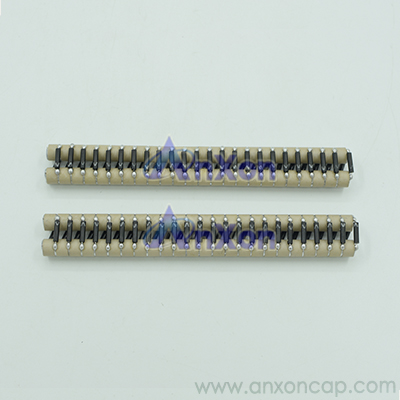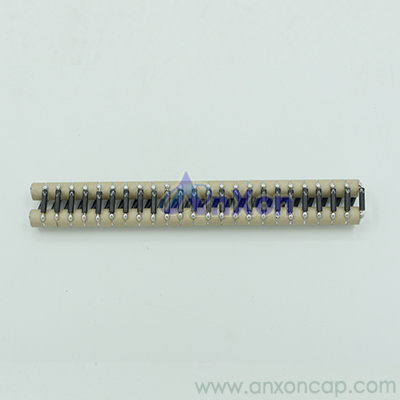


Type: CERAMIC CAPACITOR
Place of Origin: Zhejiang, China
Brand Name: AnXon capacitor & diode multiplier module
Capacitance: 350PF, 350pF
Media Available: datasheet, Photo
Package Type: Through Hole
Rated Voltage: 30KV, 30KVDC
Operating Temperature: -40 ~ +85℃
Application: RF / Microwave, Hight Voltage
Name: capacitor & diode multiplier module
No of capacitors: 24
Capacitance tolerance: 10%(K)
Output voltage: 40kV~150kV
Brand: AnXon
Certificate: RoHS/CE/ISO9000
|
30KV 350PF 24 stacks with 20KV 10mA 100nSdiodeHigh voltage ceramic multiplier assembly
AnXon provide high quality customized ceramic capacitor stacks and High Voltage Ceramic Capacitor Multiplier Sets, Please see below table to select our standard parts.
Ceramic capacitor stacks have been developed for use in low power voltage multipliers used in high voltage DC generators. The major applications are x-ray equipment for medical diagnostics or electrostatic paint spraying equipment.
HV Voltage Multiplier Unit Application Guide
The major applications are x-ray equipment for:
• Medical diagnosis
• Dentistry x-ray application
• Industrial x-ray for material control
• Airport security x-ray scanner
• Low power voltage multipliers
• High voltage DC generators.
• X-ray equipment for medical diagnostics
• Electrostatic paint spraying equipment.
High voltage radial lead disc ceramic capacitor from AnXon are 100% tested of the below parameters
• Capacitance
• Dielectric withstanding voltage
• Dissipation Factor
• Insulation Resistance
Cixi AnXon Electronics Co., Ltd. has been committed to provide customers with proven, reliable and customized electronic components. After more than ten years of development, AnXon ceramic capacitor products have successfully replaced imported international brands AVX, TDK, Murata, Vishay also exports a large number of markets in North America, South America, Europe, Middle East and Southeast Asia.
Caution (Rating)
1. Operating Voltage When DC-rated capacitors are to be used in AC or ripple current circuits, be sure to maintain the Vp-p value of the applied voltage or the Vo-p which contains DC bias within the rated voltage range.When the voltage is applied to the circuit, starting or stopping may generate irregular voltage for a transit period because of resonance or switching. Be sure to use a capacitor with a rated voltage range that includes these irregular voltages. 2. Operating Temperature and Self-generated Heat
Keep the surface temperature of a capacitor below the upper limit of its rated operating temperature range. Be sure to take into account the heat generated by the capacitor itself. When the capacitor is used in a high frequency current, pulse current or similar current, it may self-generate heat due to dielectric loss. The applied voltage load should be such that the capacitor's self generated heat is within 10°C at an atmosphere temperature of 25°C.
Notice (Rating) Capacitance change of capacitor 1. Class 1 capacitors Capacitance might change a little depending on the surrounding temperature or an applied voltage. Please contact us if you intend to use this product in a strict time constant circuit. 2. Class 2 and 3 capacitors Class 2 and 3 capacitors with temperature characteristics B, E and F have an aging characteristic, whereby the capacitor continually decreases its capacitance slightly if the capacitor is left on for a long time. Moreover, capacitance might change greatly depending on the surrounding temperature or an applied voltage. So, it is not likely to be suitable for use in a time constant circuit. Please contact us if you need detailed information.




























